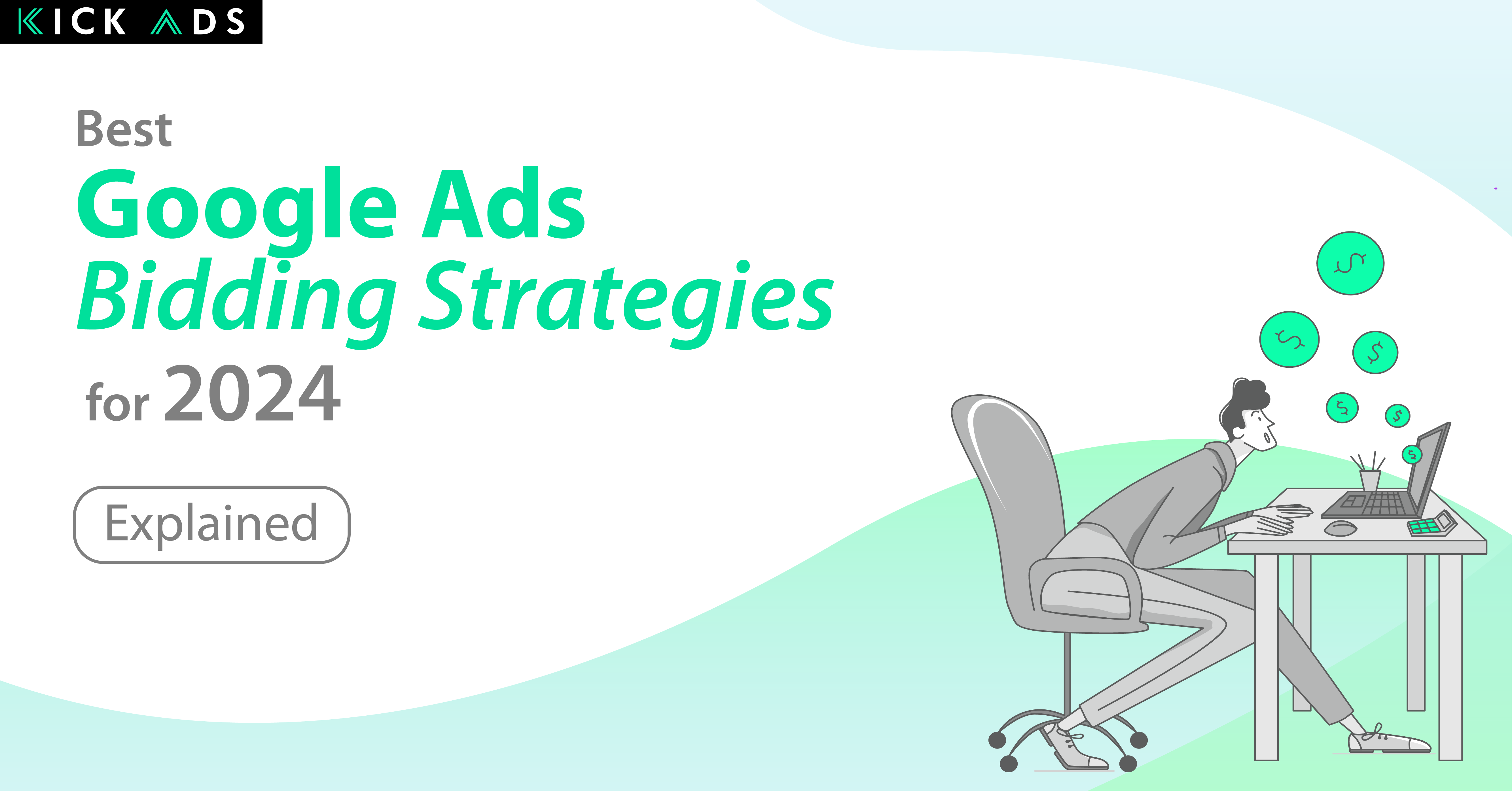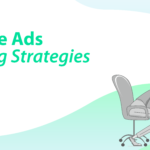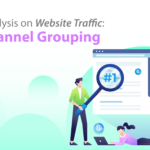Google Ads Bidding Strategy
Since 2018, Google has been pushing us to use Smart Bidding. They’ve talked about it a lot publicly, and our Google account manager has also stressed its benefits and importance privately. (You know, because getting people to use their products is a big part of their goals!!!) Google says that Smart Bidding is the way to go. They claim it makes ad performance better by using the latest tech to turn visitors into customers more easily and by using machine learning to spot trends for getting more conversions. But is Smart Bidding really as good as Google says? This article will take a closer look at how well Smart Bidding works for keyword bidding.
There are basically two ways to handle bidding strategies: Automated Bidding and Manual Bidding. In Automated Bidding, Google sets your bids for you based on certain conditions. In Manual Bidding, you control and set the bids yourself for each ad group or keyword.
The following are the bidding strategies by Google Ads:
- Maximize Clicks
- Manual Bidding
- Target Impression Share
- CPM
- Enhanced cost-per-click
- Maximize Conversions
- Target CPA
- Maximize Conversion Value
- Target ROAS
https://support.google.com/google-ads/answer/2472725?hl=en
Google often talks about Smart Bidding, but what exactly is it? Smart Bidding is one type of Automated Bidding strategy. It focuses on conditions related to conversions to help you bid automatically. Smart Bidding uses machine learning technology to optimise bids during each auction, aiming to improve the number or value of conversions.
1. Maximise Clicks
If you don’t have a set way for getting conversions and just want people to visit your website, “Maximise Clicks” will automatically adjust your bids to meet this goal. If your website doesn’t get a lot of traffic, you should start with Maximise Clicks. You can apply this bidding strategy to your ad campaigns.
When should you use Maximise Clicks?
If you’re setting up your keyword ads for the first time and have no idea about the cost and conversion rates of keywords, you can start with Maximise Clicks to bring as much traffic as possible to your site. Once you begin to understand the price and approximate ranking of each keyword, you can switch to other Smart Bidding strategies or Manual CPC to aim for better performance. Maximise Clicks is a good initial bidding strategy because its focus is on bringing the most traffic with a limited budget, since it tends to favor lower-cost keywords, which might not always be beneficial if their conversion rates are low.
A little tip: When setting up this bidding strategy, it’s recommended to select ‘Set a maximum cost per click bid limit’ to prevent the CPC from exceeding a certain amount. For example, if the Bid limit is HK$10, then each click won’t exceed HK$10. If we don’t set a bid limit, the system might push the CPC too high; if the bid limit is set too low, there’s a chance your ads won’t run. So, remember to check your Google Ads performance 2-3 days after setting up your ad.

2. Manual CPC
Manual CPC, or manual cost-per-click bidding, means you set the CPC for each keyword yourself. This approach lets you control the maximum amount you’re willing to pay for each click. This bidding method gives you more control, allowing you to adjust according to your budget and goals.
There are several benefits to Manual CPC: First, it lets you control the cost of each click precisely, fitting your budget. Second, you can perform A/B tests, trying different CPC bids to find the one that gives you the best return. The most important thing is it helps avoid overspending, preventing the kind of overspending that can happen with automated bidding, especially when you need more control over your budget.
However, while Manual CPC gives us complete control, it requires time and effort to monitor and adjust regularly, which can be time-consuming and demanding. Also, because adjustments are manual rather than based on real-time data, the response might not be as quick as with Google’s automated bidding strategies, leading to a drop in efficiency. In recent years, we’ve found that manual bidding can’t compare with automated bidding options, so we generally don’t recommend it.
3. Target Impression Share
Target Impression Share is a bidding strategy aimed at increasing visibility. We can use it to control how often our ads appear on the search results page and ensure they show up in specific positions. If you’re focused on brand exposure and want your ads to be seen more, using Target Impression Share is a great fit for you!
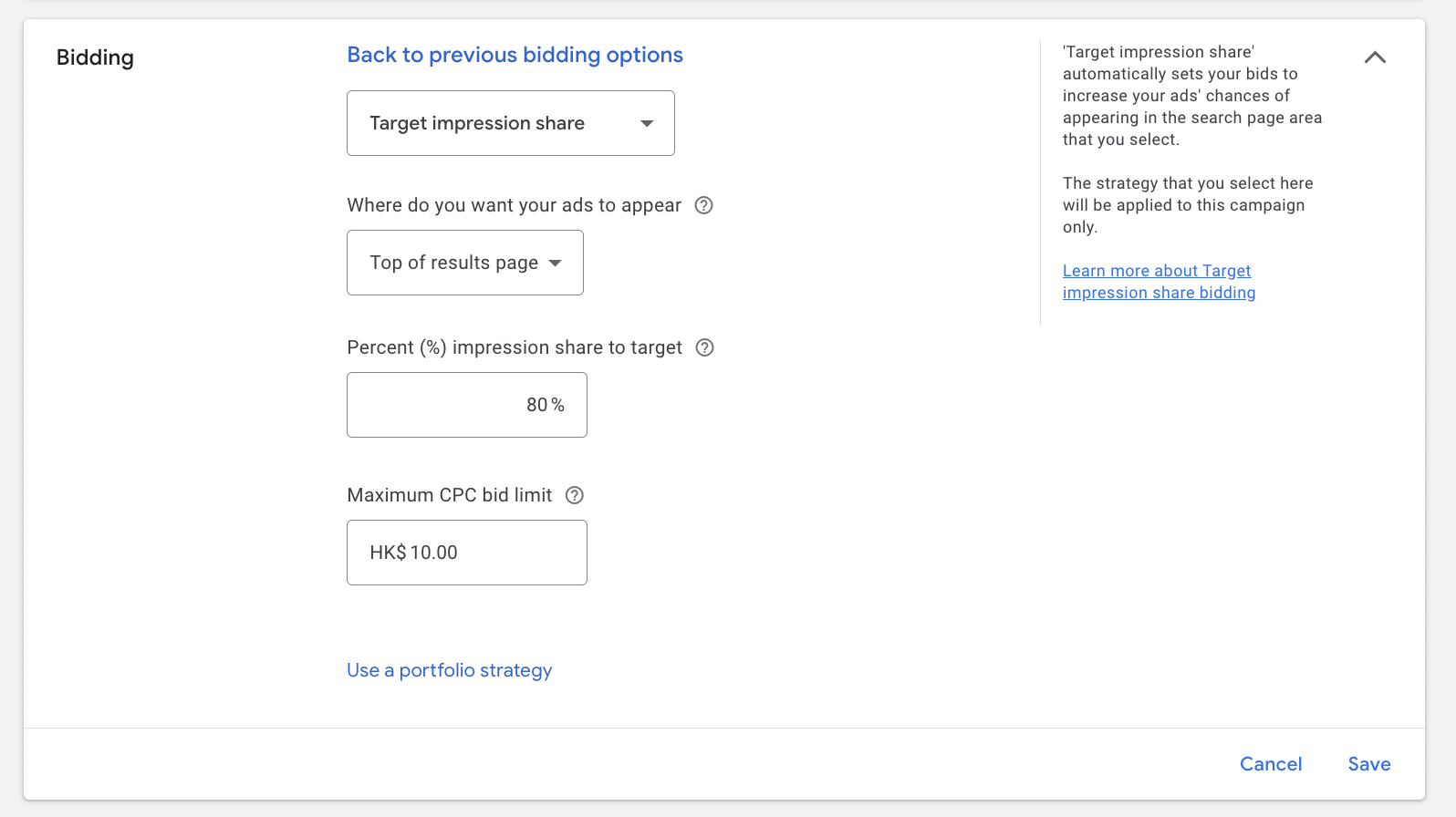
We can set our ads to appear Anywhere on the result page, at the Top of the results page, or at the Absolute top of the results page on Google search results. Plus, we aim for a certain percentage of Impression Share, and after setting a Maximum CPC bid limit, we’re all set. For example, in a Brand Search Campaign, when my brand is searched for, I want most of my ads to be at the very top. I would choose Absolute top of the results page and aim for 90% Impression Share.
Although this sounds simple, it’s actually a bit complex. Being in the first position doesn’t mean you’ll get more conversions. The ad’s position is not always the most important factor, and maximising Impression Share could significantly increase CPA (Cost Per Acquisition). At the end of the day, what’s most important is the number of conversions and the conversion rate. What does it matter if your rank is higher or if your ads appear more frequently? What’s crucial is finding your own sweet spot. That’s why we rarely use the Target Impression Share bidding strategy.
4. CPM
CPM, or Cost Per Thousand Impressions, is mainly used for Display Ads in Google Ads. Simply put, this bidding is based on how much we’re willing to spend for every 1,000 impressions. It’s a bidding strategy aimed at getting the most Impressions. If you have some image ads and you need to reach a certain number of Impressions, then this strategy is the best fit for you.

The screenshot above demonstrates the same Display campaign, under the same Audience and with the same image ads. Bidding with CPM indeed makes the CPM cheaper and the Impressions higher, but the CPC more expensive and the Clicks fewer. So, if your ads are focused on getting exposure, go ahead and choose CPM!
5. Enhanced CPC
When the algorithm thinks there’s a higher chance of conversion, Enhanced CPC (ECPC) will automatically raise the bid to maximise conversions, so the cost per click can’t be controlled even if you initially set up Manual CPC because you chose ECPC.
What’s the difference between ECPC and Target CPA?
With Target CPA, advertisers can set a CPA (cost per acquisition) target for each conversion, whereas ECPC tries to attract the most conversions by increasing the maximum cost per click.
However, be careful! ECPC used to have a 30% bid adjustment cap, but this limit was removed in May 2017 across all locations and audiences. This means your bids could fluctuate more significantly, thus requiring stricter monitoring.
When to use Enhanced CPC?
Personally, I find it somewhat underwhelming—it’s not as controlled as Manual CPC, nor as smart as Target CPA. So, I really haven’t used it in recent years. If anyone has something to share, let me know.
6. Maximise Conversion
Is Smart Bidding worth using in 2024? Before updating this article, the not-yet-matured Maximise Conversions strategy from a few years ago was indeed shocking. Conversions increased, but the accompanying CPA (Cost Per Acquisition) was uncontrollable. However, as time passed, Maximise Conversions has truly helped many find more conversions. Let me explain this bidding strategy to you.
First, you must define your conversions. If your conversion is defined as 3 pageviews or visiting the contact page, then Maximise Conversions will optimise based on the conversions you have set. If browsing the contact page is your conversion goal, Google Ads will focus on driving customers there. So, it’s advised to set conversions that significantly impact your business, like Contact Form Submissions, Sales, or Phone Calls.
Once you’ve set your conversions, you can choose Maximise Conversions as your bidding strategy. As usual, no bidding strategy guarantees success, so please try it for at least 30 days and then review your data to decide if it’s worthwhile. Here is some advertising data from 2023.

In June 2023, we were still using Maximise Clicks. In July, we switched to Maximise Conversions. The result was that although the Avg CPC increased by 60%, it brought about 1.5 times more conversions, and the CPA was much cheaper, so we decided to continue using Maximise Conversions.
Does this always improve ad performance? Not necessarily. Many ads saw a significant increase in CPC after adopting Maximise Conversions, but the conversions didn’t increase as expected, leading to a sharp increase in CPA. So, you should observe for 14 – 28 days. If the performance isn’t good, just feel free to switch back to Maximise Clicks to control the CPC!
7. Target CPA
Target CPA allows you to set a target cost per conversion, thereby enabling the system to get the most conversions within your CPA (Cost Per Acquisition) target. In simple terms, it means lowering your usual CPA to make your advertising costs lower. From Kick Ads’ experience, we usually use 3 months of data to determine the bidding for ad CPA. To get the most out of the Target CPA strategy, you must have conversion data, ideally more than 15 conversions in the past 60 days!
In operation, you can first switch the bidding strategy to Maximise Conversion, then the option below for setting a target cost per action is where you select Target CPA.
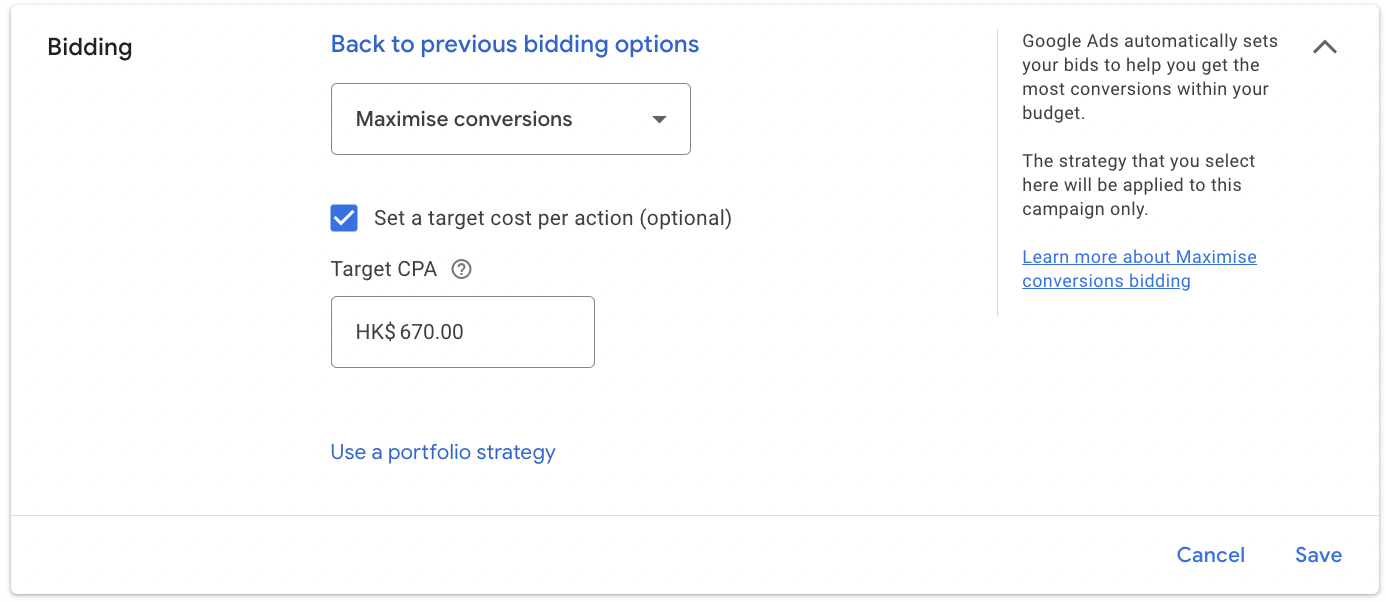
Successful Case:
It seems like you’re describing an advertising performance transition from Maximise Clicks to Target CPA, where November 2023 shows the performance under Maximise Clicks, and December 2023 under Target CPA. If there’s more specific data or results you’d like to discuss or have questions about, feel free to share, and I can help analyse or provide insights based on that information.
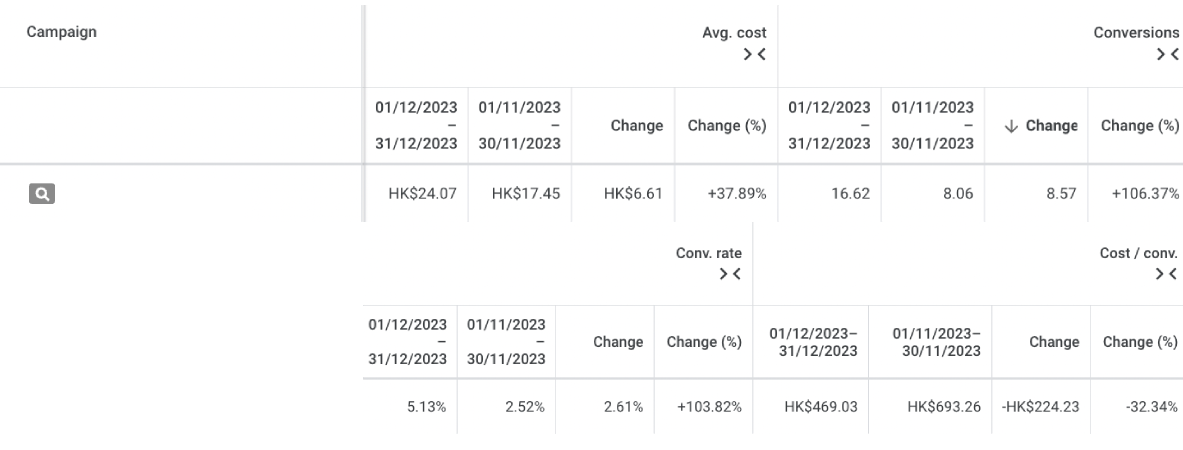
Like Maximise Conversions, after adopting Smart Bidding, the Avg CPC increased by 38%. However, there were significant improvements in Conversions, Conversion Rate, and CPA. The advertising spend in December went up by 37%, indicating that despite higher advertising costs, we were still able to achieve more conversions at a cheaper CPA. This means we can scale up this advertisement. The transition to Target CPA was successful.
Things to consider when switching to Target CPA
- It’s recommended to observe for at least two weeks up to a month. If the performance significantly improves, with both CPA and Conversion Number/Value meeting expectations, then continue using Target CPA.
- Only experiment with sufficient budget and at least two months of conversion data to avoid wasting effort on campaigns with few conversions.
- Assign an independent Target CPA to each campaign for optimal results, as CPA varies across different types of Keywords/Campaigns. For example, Branded Campaigns typically have lower CPAs than Generic Campaigns.
- If your ads suddenly underperform after switching to Target CPA, it could be due to an unrealistically low Target CPA setting. Ensure the Target CPA is realistic; setting it too low may result in fewer conversions and poor ad performance. Regularly review and adjust your Target CPA to align with actual ad operations.
8. Maximize Conversion Value
If you are an eCommerce store owner, Maximise Conversion Value would probably be the ideal bidding strategy for you. In simple terms, you first need to set up your conversions, whether through Google Tag’s Conversion Tracking or GA4’s conversion value. Setting up the conversion value correctly is a fundamental condition for this campaign strategy.
Once you’ve chosen Maximise Conversion Value as your ad’s bidding strategy, the Google Ads system will strive to achieve the highest Conversion Value. Therefore, after setting up your ads, if you’re unsure about the expected ROAS (Return On Ad Spend), you can opt for Maximise Conversion Value to discover the highest conversion value.
9. Target ROAS
Return on Ad Spend (ROAS) measures the average value you gain for every dollar spent on advertising. The Target ROAS strategy focuses on achieving your desired return on ad spend. In simpler terms, it calculates how much revenue or conversion value you get back for every dollar of ad spend. Unlike Maximize Conversion Value, which aims to achieve the highest conversion value, Target ROAS is more about reaching your required ROAS under a limited budget.
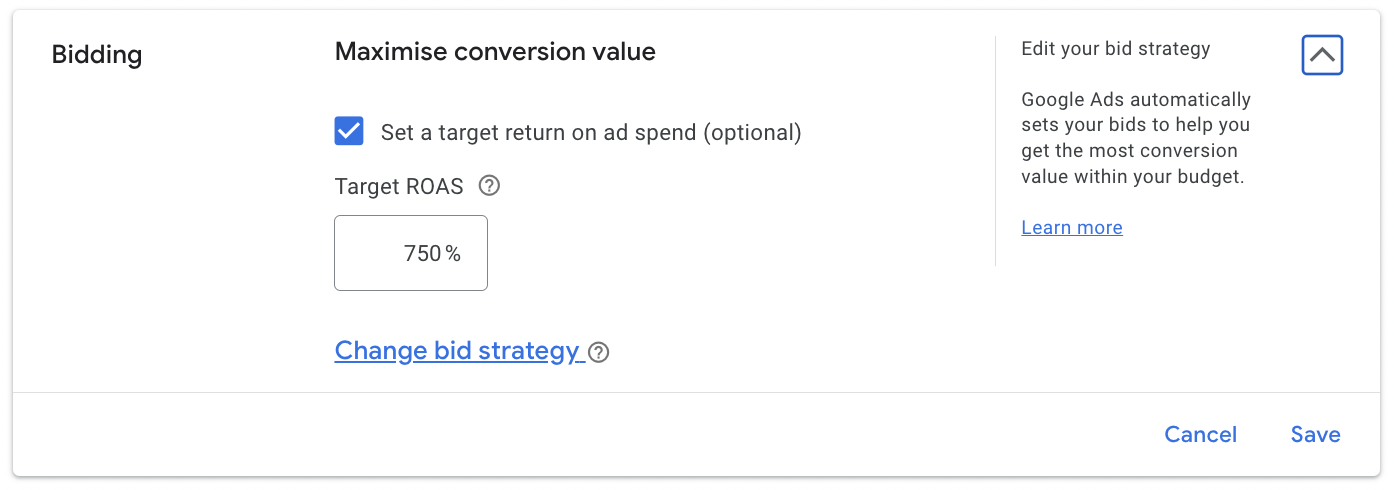
When should you use Target ROAS?
For eCommerce store ads, start with Maximise Conversion Value to aim for the highest conversion value. Once you understand how much conversion value each ad budget brings, you can approximate its ROAS. After about two months, consider setting a Target ROAS based on the last 30 days’ ROAS as a reference. Don’t set your Target ROAS too high; unrealistic expectations can halt your ad performance!
How to choose your Bidding Strategy?
Choosing the right bidding strategy for your ads involves the following steps based on years of experience:
- Start with Maximise Clicks: Aim for the most clicks and use Google Ads’ Keyword Planner to estimate the CPC for each keyword. Set this CPC as the Bid Cap (Set a maximum cost per click bid limit) in your ad campaign. This will not only garner clicks for a new ad campaign but also ensure that the average cost per click remains within a reasonable range.
- Transition After 14 – 28 Days: Once your ad campaign has been running for about 14 to 28 days, you should have a stable conversion rate and cost per conversion. If your campaign is lead-generation focused, switch your bidding strategy to Maximise Conversions. Ensure you have enough conversion data for Smart Bidding to be effective, ideally between 14 to 28 days. Don’t switch all ads to Maximise Conversions at once; start with the campaigns that have the most conversions. If you’re an eCommerce merchant, the same applies, but switch to Maximise Conversion Value to get the most conversion value.
- Allow the System to Learn for About 28 Days: After this period, your ads should have a stable conversion cost or ROAS. Now you can switch to Target CPA (for lead generation) or Target ROAS (for eCommerce). Don’t set an unrealistic ROAS/CPA; the system needs 1-2 months to stabilise the data to improve ad performance.
- Regularly Review Your CPA or ROAS: If the CPA is set too low or ROAS too high, your ads may not run effectively. If there’s improvement in CPA or ROAS gets better, consider lowering the Target CPA or Target ROAS further. If Smart Bidding makes the average CPC too expensive without a corresponding increase in conversions, consider switching back to Maximise Clicks and repeating the process for better results.
There’s no one-size-fits-all in bidding strategies; adjustments should be based on your advertising goals. Don’t be lazy; always observe and optimize. If you need help reviewing and improving your Bidding Strategy, Kick Ads is here to assist!
